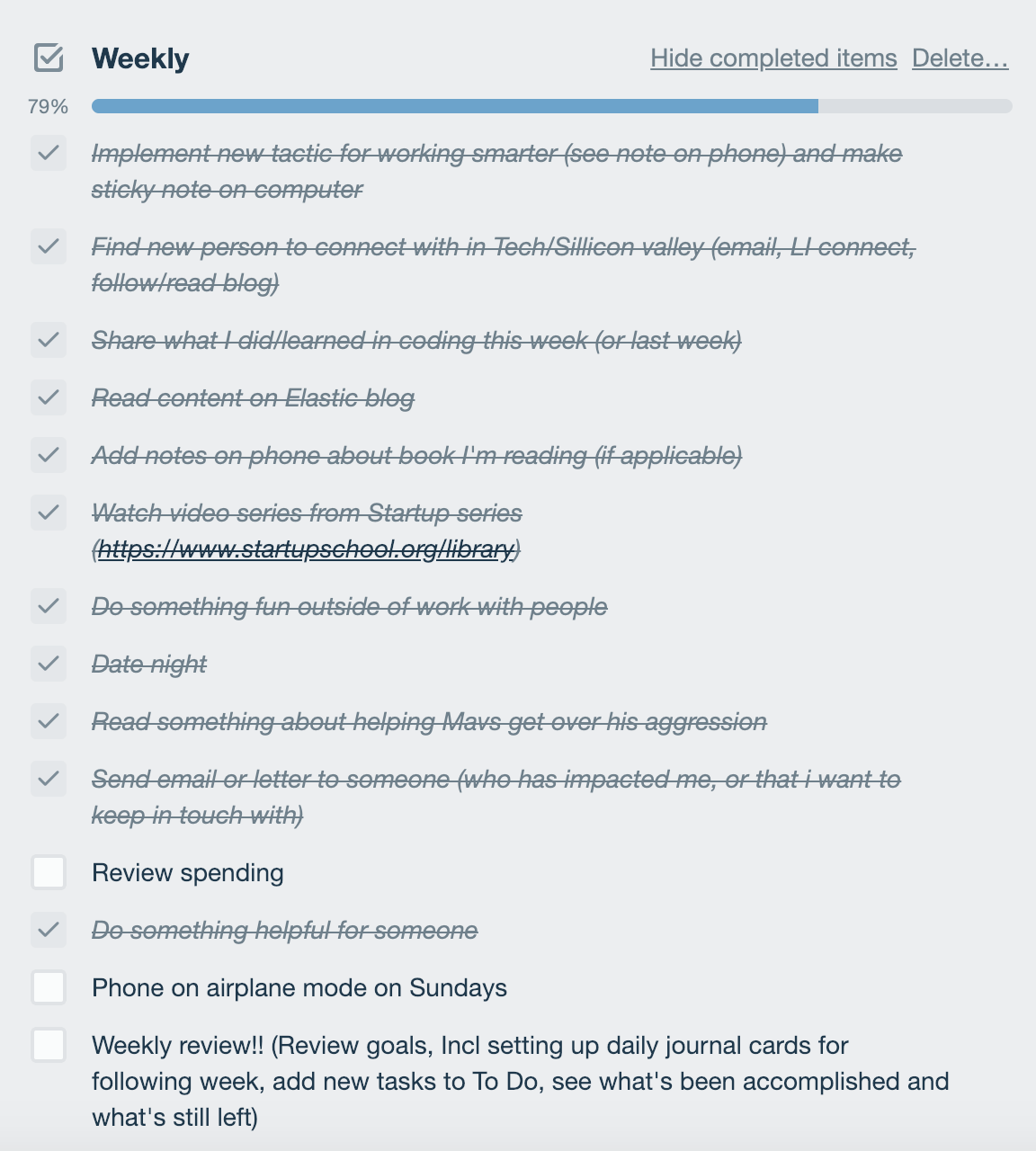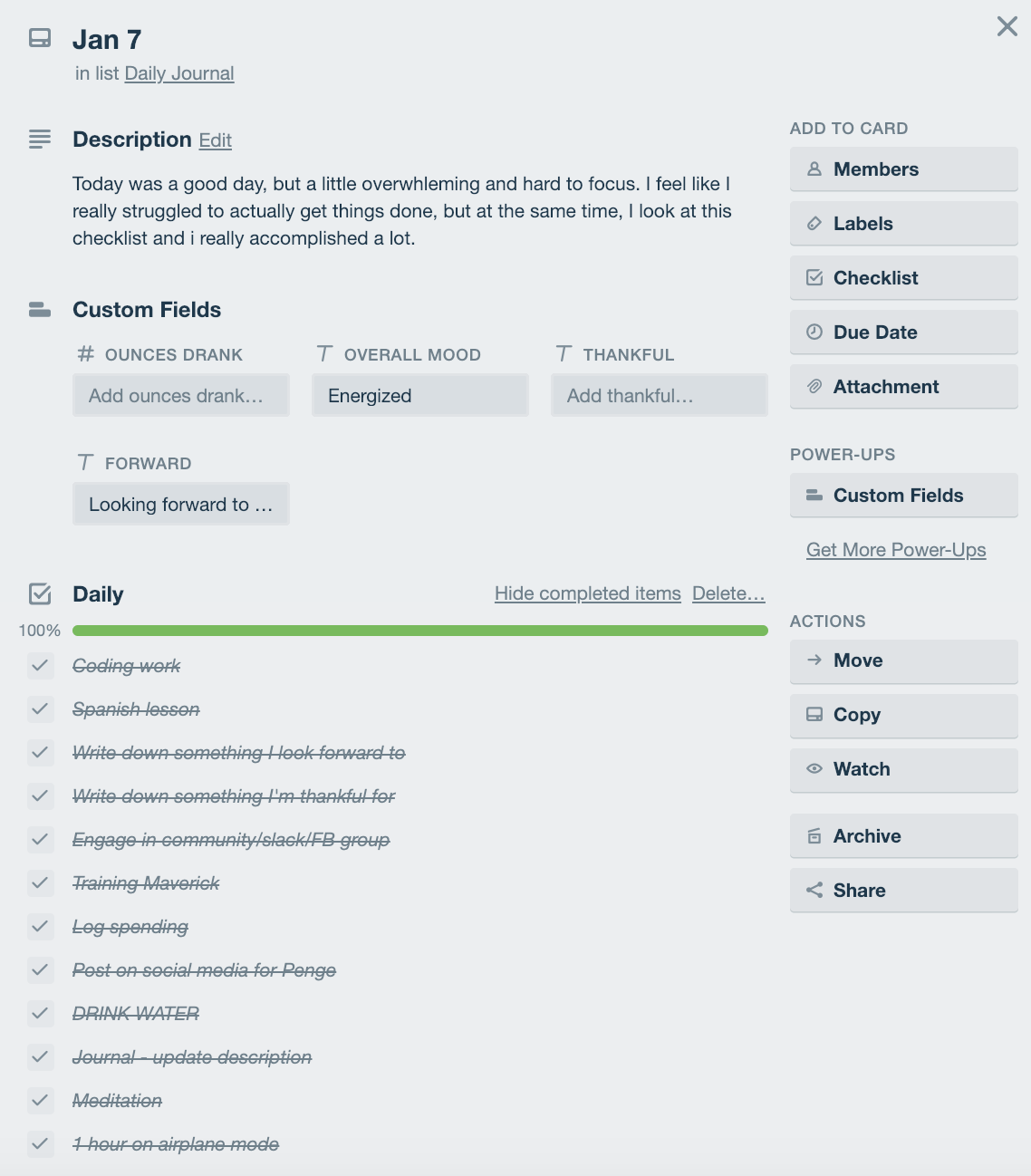Every start to a new year is the opportunity to try something new and different. It’s the perfect time to reflect on the previous year, analyze what worked and what didn’t, and to make plans to improve certain or all areas of your life.
Despite building a weekly review ritual workflow that kept me productive, focused, and able to accomplish all of my projects, 2018 was a year of setbacks for me… in just about every area of my life.
I was burnt out, I lost a lot of momentum on all the things I’d been working on, and I just generally felt really drained. My body and mind was on auto-pilot to churn out work instead of growing as a person and reaching my long-term goals. It was as if I was just going through the motions, and all these projects were just short term activities with no real direction.
I decided this year I wanted to take a new approach. Instead of listing out projects, I wanted to build systems and habits that would hold me accountable to my goals along the way. Instead of sprinting, I wanted to create small, sustainable habits that would help me cross the finish line with more ease.
Find The Why
My goal has never been to just work on a bunch of projects. When I thought about what I really wanted, it was to grow into the type of person who made small progress on my lifelong goals every day, week, and month so it was a part of my life instead of something I just did for the sake of doing.
My plan was to see if I could turn my goals into tiny actions so I could achieve them through small milestones. For example, rather than saying “Run a marathon” and make a Trello card for that, I’d have a daily checklist that included running a little bit every day.
I wanted to make these projects bite-sized so they became a part of my daily routine, rather than large efforts compartmentalized as “work” or separate efforts saved for my free time outside of my full-time job.
(I won’t lie – it was also a fun way to see if I could use Trello in yet another way besides just managing my workload, but also incorporating a personal development aspect into it.)
At first I thought, maybe this was a bit extreme. But then I did some research and found that creating better personal systems is actually a much more sustainable way to make progress toward your goals. Creating habits and processes that lead you to what you want is better than just listing arbitrary goals, with no apparent path. As James Clear says, “If you completely ignored your goals and focused only on your system, would you still succeed?”
I wanted to build that system that would let me say “Yes!” with confidence.
So off I went to create this new Trello board and see if I could accomplish my goal to really help me move forward and not just see my life as a series of projects.
The result is my Daily Habits + Goals Tracker board, and I’m thrilled with how it turned out.
But how does it work? I’m so glad you asked.
Start By Setting The Building Blocks
My very first list is a Table of Contents (TOC). Just like in a book, the Table of Contents is meant to give you high-level direction before you dive into anything specifically.
I use a few cards with labels, emojis, and all caps to make subsections within my TOC.These subsections include:
- My overall vision: Any words or themes I’ve chosen for the year, plus my recorded so that I can refer to them regularly. Did you know writing out your goals and reading them regularly sets you up for more success?
- Upcoming dates: Important dates worth noting, which could be upcoming trips or other special occasions. I still document these in my calendar, but it’s nice to see a list view of them, as there is usually some extra planning that goes into these items.
- Upcoming expenses: Personal finance is really important to me, and it’s helpful to see things that I need to prepare for down the road rather than getting to March and suddenly seeing that semi-annual car insurance payment due.
You might choose other categories, but the overall goal of this section is to keep you focused and inspired with a mountain-top view.
Map Out Your Goals And Projects
I know I know, I said the goal of this board was to be more than just a workflow. But we still have to have the workflow in there, because the real goal is about creating balance, not avoiding projects!
My next list is called “Backlog”, and the point of this is to identify the projects I need to accomplish. However, these should be one-off activities, so a recurring card should never live here. (I’ll explain why soon.)
In order to make sure I don’t get obsessed with projects, I have a few boundaries for adding cards to this list. First of all, my examples here are actually things that can be accomplished in a few hours or less. Each one is not massive project that is going to require tons of effort. (But how do I accomplish those things that do require lots of effort? Stick with me—I’ll get there!)
Next, I can’t just add something in here any time I want. It has to have some criteria before edging its way onto the master list.
1. It has to fit my priority categories. I identify the categories of my projects and tasks through labels. If something doesn’t have a label, then it’s not a priority and doesn’t get added onto my list of projects.
2. A project or task has to be something that contributes to my annual goals (see the TOC). This should be closely aligned with my priorities, but my annual goals require more specific criteria.
3. Emergency extras. If it doesn’t fit those two categories, I’ll occasionally make exceptions, but it better be a compelling case. Otherwise, it’s going to sit on my idea list (this is a simple list at the end of my board) and I’ll come back and assess it later.
Making The Magic Happen
Each week, I move things into my “To Do” list. Some of those things come from my Backlog, but wait! There’s a card called “January”… and one with a week on it! What’s that all about?
This is where the magic happens, my friends.

This card structure is how I make progress. It’s not through the cards I drag over to “Done”, but in the checklist items that help me chip away at my big goals.
Instead of making a bunch of cards for all the things I want to do this year, I asked “What’s a minimal action that I could take every day, week, and month to help me make progress on this goal?”
Here’s how this workflow looks in relation to my annual goals:

I do this for each of my goals in various sections of my life including career, finances, relationships, and side hustles. Next, I take the monthly activities and make a checklist in a Trello card and title it “Monthly Checklist”. Each month I have a card like the January one that shows me everything that needs to be accomplished during that month. These are the small actions that lead to accomplishing my large goals.

I do the same thing for my actions each week, and create a weekly checklist card of things to accomplish. It almost feels like a scavenger hunt! When I have a few free minutes, I scan through the list and see what I can knock off.

It might look like a lot of tasks, but it doesn’t feel so daunting when it’s just a tiny line and there’s a box you can check. (It’s even more satisfying that Trello draws a line right through it when you check of an item on your to-do list!)

Also, most of these tasks aren’t daunting. I leave just a little bit of ambiguity in the definitions so that I have room to choose larger or smaller tasks depending on what else is happening in my life. But no matter what, even if it’s small, I’m making progress toward my goals and growing as an individual.
My “Doing” and “Done” lists are just spaces to drag things over to help me sort what’s in progress and what’s been completed for anything outside of those checklists. Again, things in this should be pretty minimal, but there will always be projects that come up that I don’t want (or need) to fit into an ongoing plan
Creating The Right Daily Habits
So I’ve shown you my monthly and weekly cards, but I also made a special checklist for my daily cards.
This list is separate because these cards won’t get archived. Instead they’ll remain in this list to serve as a daily journal and something I can easily go back and reference.
I got this idea from a friend who recently started using Trello. She showed me how she was using Trello to manage her personal journal. I’ve never been much into journaling, but she showed me how she uses Custom Fields Power-Up to document specific aspects of her day and checklists for things she wanted to accomplish each day.
I was inspired to give it a try myself, and while I’m still not much for journaling, it’s a perfect way to encourage myself to create daily habits and to be more intentional about my thoughts each day. Reflection is crucial to progress.
Here’s what a daily card looks like:

Here are a few Trello Power-Ups and features that supercharge my card workflow and journaling:
- Custom Fields: Seeing empty boxes makes me squirm, so the Custom Fields are a great way to force me to write something down, even though I don’t like to journal. I’m focusing on my #AttitudeOfGratitude this year so I have two Custom Fields on my cards: one with a box to write what I’m thankful for, and one to write what I’m looking forward to that day! (Editor’s note: Custom Fields in Trello are currently set up to display on every card on the board where they are enabled, and cannot be customized to only display on a specific list or set of cards.)For a field that intakes numbers, I use the Number Stats Power-Up to sum up the numbers in all of those fields across my entire board—I’ll be able to track how much water I drank over time!
- Checklists: Just like the monthly and weekly checklists, daily checklists help keep me on track as well. Each item represents a habit I want to build, or a small action I want to take towards my annual goals. For ideas on new habits to try, see the habits of other productivity enthusiasts.
- Description: I use the card description as an open space to write anything else about my day that comes to mind. It can be formatted nicely too, since the descriptions support Markdown!
Hold Yourself Accountable To Achieving Goals This Year
If you’re ready to make progress on your goals and accomplish your New Year’s Resolutions, try out this accountability process and see if it works for you.
Albert Einstein once said, “Everything must be made as simple as possible. But not simpler.” Lean into the simplicity this year, and focus on creating the right systems and habits to set you up for success.
I’m already seeing fantastic results and it feels like a more sustainable way to get things done. I’d love to hear what you think, so share your thoughts with me on Twitter (@brittany_join)!
Next: 3 Ways To Approach Goal Setting As A Team (And Actually Enjoy The Process)

